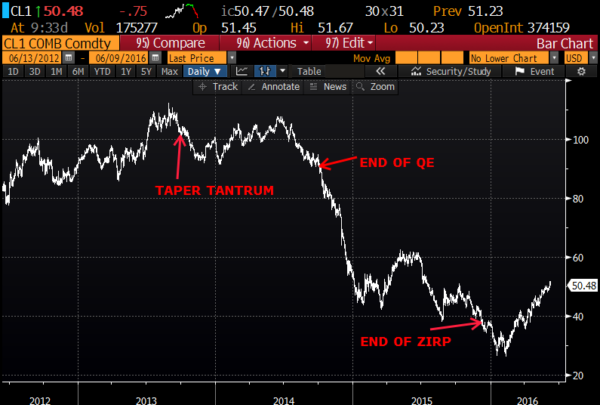Context matters in most things in life. While the nearly 95% bounce in oil from the February lows might be explained by an uptick in demand, or a decrease in supply, the reality is it has had little to do with either. For all intents and purposes, the sharp decline in crude started in the second half of 2013 when the Fed floated the trial balloon of a tapering of QE, and then began in earnest when they ended QE in Q4 of 2014 and then the bottom fell out when they ended their zero interest rate policy in December of 2015.

The subsequent rally from the February lows is the result of the U.S. Fed doing an about-face on their plan to normalize interest rates. That caused the dollar to decline and U.S. Treasury yields to threaten all time lows. We are back to the ol’ QE playbook.
As my pal Jay Pelosky stated in a guest post the TickerDistrict back in early March from his Itau Global Connections peice, Why the World Needs a Weak Dollar:
Mainly because there are so few other options to lift the global economy and prevent a global slowdown morphing into a global recession. That we are in a global slowdown is news to no one… what comes next is of interest to all – politicians, policymakers and investors alike.
Global growth is under pressure in large part due to three negative and mutually reinforcing feedback loops. These three negative feedback loops are the Fed rate tightening cycle, which remains in place until the Fed says otherwise; China’s economic rebalancing and reform efforts centering around the State Owned Enterprises (SOE); and the general upheaval and dysfunction in the global commodity markets. All three are anti-growth and anti-inflation. The USD links all three together.
Everyone, and I mean everyone needed a little respite from U.S. dollar strength. And they got it. The U.S. Fed once again seems more inline with most other major central banks. What comes next might though, might not exactly be the thing that stimulates growth.
For risk assets, the very financial conditions that caused the Fed to halt their hiking bias earlier in the year have by most measures eased dramatically, with the S&P 500 (SPX) within 1.5% from its all time highs, equity vol in one of those QE/ZIRP induced dirtnaps, high yield credit (HYG) at 2016 highs, as is oil and most other industrial commodities. This all makes some sense because of the dollar move, and what was clearly an overshot to the downside in Jan/Feb and now the last few months with investors caught off-sides.
But I see two scenarios in the coming months, neither great for U.S. stocks:
1st, the U.S. Fed surprises the world with a rate hike in June or July (this is highly unlikely with current probabilities based on Fed Fund Futures at 0% and 18% respectively, down from 35% and 55% just 3 weeks ago) and most risk assets correct 5 to 10%.
Or 2nd, the U.S. Fed does nothing and remains vague about the course of monetary policy. This would cause increased uncertainty and Treasury yields make new lows, causing investor panic that the U.S. Fed lacks ammo if in fact we and the globe do in fact have a recession. In this scenario I think investors will focus on the countries and regions like Japan and Europe which make up the majority of sovereign debt in negative yields and consider just how their equity markets have fared over the last year as negatively yielding sovereign debt has exploded from $1 trillion to $10.5 trillion. Spoiler Alert: the Nikkei is down 20% from its 52 week year ago highs, as is the Euro Stoxx 50 (SX5E).
While the SPX may certainly make an attempt at a new high, I doubt it will stick and I worry that what everyone wants, is not exactly what everyone needs. Committing new capital to U.S. equities because “economic conditions” have eased on the stabilization of oil, the decline of the dollar and weakening Treasury yields seems like a fairly dangerous cocktail at this stage of the bull market and economic expansion that started in early 2009, which for all intents and purposes has yielded few sustainable growth antidotes other than inflating risk assets.